Nitroammofoska is a complex mineral fertilizer. It contains the three most important macronutrients for plant nutrition - nitrogen, phosphorus and potassium (NPK). On the use of fertilizer in the garden talk below.
Table of contents
Purpose and composition of nitroammofoski
The substance has the form of rounded granules of pinkish or grayish hue. They are easily dissolved in water and in the ground, so they are suitable for:
- soil application;
- fertilizer irrigation;
- spraying.
Each granule contains a complex of chemical compounds. The total mass fraction of nitrogen, phosphorus and potassium is about 50%, which is considered a very good indicator. In soil solution, nitrogen works in two forms: nitrate ions and ammonium ions (this is where the name comes from nitro and ammonium). Phosphorus is represented by three ions. This variety improves nutritional absorption. Potassium is usually present in the form of sulphate, which provides additional enrichment with a small amount of useful sulfur. Harmful chlorine is usually not.
Advantages and disadvantages of fertilizer
The range of complex mineral fertilizers is quite extensive, and sometimes it is difficult to understand the names.
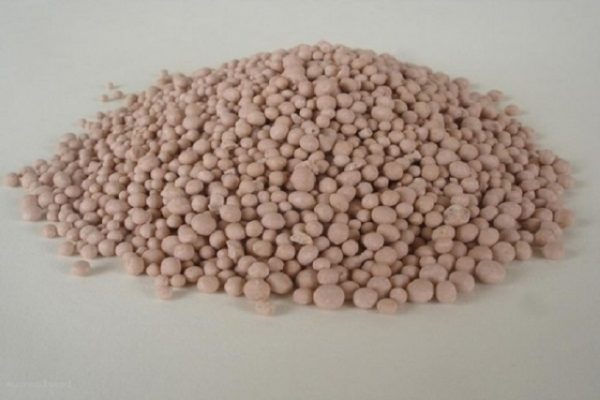
Delimitation
Ammofoska and diammofoska - have similar basic components (NPK), supplemented with magnesium and a rather large amount of sulfur. Nitrogen from ammonium phosphate (ammonium ion) does not accumulate in the form of nitrates in plants, but is partially lost after application (it is washed away, evaporates from the soil).
Nitrofoska sometimes appears as an analogue of nitroammofoski, but initially there are differences between them. Nitrophoska additionally contains magnesium, but it has poorly soluble phosphorus compounds, and harmful chlorine is often present. Nitrogen is contained in only one form - nitrate.
Nitroammophos and Ammophos - two-component substances (nitrogen and phosphorus without potassium).
Advantages:
- Universality: suitable for all types of soil and different crops.
- The optimal proportion of basic batteries.
- Components complement and reinforce each other.
- The granules do not slezhivayutsya, perfectly crumble.
- The drug is highly soluble.
Important limitations:
- A significant proportion of nitrogen dictates the time frame for making nitroammofoski for perennial flowers, trees and shrubs: only until mid-summer (so as not to reduce the hardiness of winter).
- Vegetables should be fertilized in the first half of their growing season. without exceeding the dosage, otherwise there is a risk of accumulation of nitrates and worse crop safety.
- For strawberries and strawberries are allowed two terms - in the spring and immediately after fruiting.
Instructions for use in the garden
Macroelement complex NPK is useful to all plants - greenhouse and soil, annual and perennial, vegetable and fruit, as well as decorative. Tomatoes, roses, grapes, and root vegetables are particularly well reacted. The yield of many crops is increased by 25-75%.
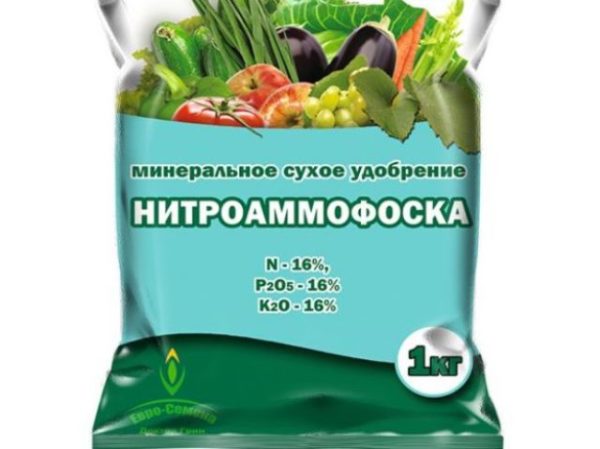
Instructions for use are quite simple:
- Spring prikopk in pristvolny circles of trees and shrubs: 40-100 g per plant.
- Pre-planting and presowing (continuous) application: dry in the spring in the course of digging (from 250 to 800 g per 10 sq. Meters). When digging in the autumn, it can be poured only on heavy loams: light and medium soils “lose” nitrogen by spring.
- Adding to the hole (before planting seedlings and seedlings, when laying tubers and bulbs):
- 4-10 g under potatoes, seedlings of vegetables and flowers;
- 50 g per bush; 100 g on the tree.
The granules are well mixed with the ground, protecting the roots from direct contact.
- Hilling potatoes - add 3 kg per hundred
- Fertilizer irrigation in the first half of the growing season: 10-20 g per bucket of water (1-2 square meters):
- lawn - after each haircut;
- wild strawberry - in spring and after fruiting;
- fruit trees and bushes - in spring and after flowering;
- vegetables, flowers - 1-3 times per season, with an interval of 1-2 weeks.
- Foliar top dressing: 15 g per bucket of water (warm) - 1-2 times per season (in the evening, moisten the foliage top and bottom abundantly).
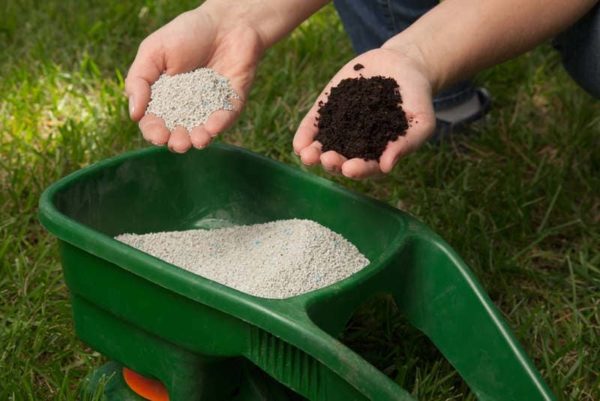
Compatibility with other drugs
It is NOT recommended to mix:
- with lime and wood ash;
- with chicken dung and manure;
- with mineral nitrogen fertilizers;
- with phosphate and potash fertilizers in the form of powder and small crystals (with granules - it is possible).
It is allowed to combine with fungicides (means for diseases) - except for those that contain copper and sulfur.
Security measures
Fertilizer is marked with the third hazard class - low hazard substance. Non-toxic. When working with it, you should use standard protective clothing, follow the rules of hygiene. Cannot be misused. In case of contact with the stomach, you need to take activated charcoal and consult a doctor if skin and eyes are affected - rinse with running water.
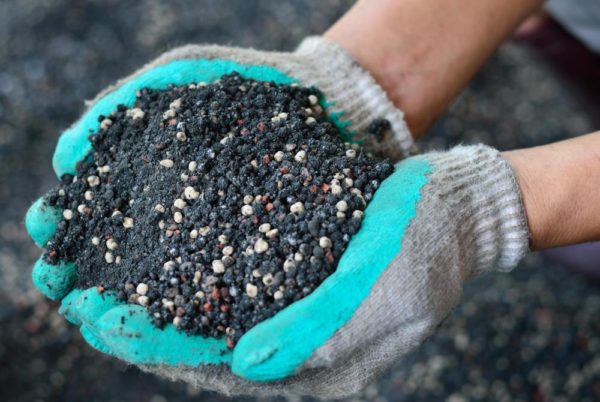
Storage conditions and shelf life
Nitroammofoska is not explosive, it ignites with great difficulty - only in the center of a strong fire. It does not emit toxic gases, but can provoke the ignition of other substances.
On the closed factory packaging manufacturers give a guarantee of 1.5 years, and on the opened - six months. Further, the nutritional properties gradually decrease, and the flammability increases.
Tool Reviews
Druzhnik S.I. (Kaluga Region): “Recently, I began to fertilize potatoes with Nitroammofoska: one teaspoon per well, then pour it with a spud. The third time - sprayed during flowering. Productivity has increased by half. "
Pronina Elena (Rostov): “We do not always have the opportunity to bring manure, so you have to feed the roses with mineral water. Tried different options. I liked the effect of Nitroammofoski, flowering is very abundant. We give it 4 times, only until mid-July, and then - wood ash. ”
Sturm G.P. (Amur region): “I scatter nitroammofoska in the spring under berry bushes - currants, honeysuckle, raspberries.I put one or two handfuls under each bush, then loosen it. After flowering, on small ovaries, I spray with the same agent - a tablespoon per 10 liters of water. Satisfied with the result. "
Connegen Vera (Altai Krai): “I use Nitroammofoska on grapes. I water it in the beginning of summer, and then after flowering I give foliar dressing. In our lands, the grapes cannot be overnourmed, therefore I do not indulge in organic matter. ”
Ageev Alexander (Moscow region): “In my garden Nitroammofoska is the main mineral fertilizer. I scatter it in the spring before plowing the motoblock. Then soot potatoes, carrots, beets, cabbage, tomatoes. Until mid-summer I still produce a couple of liquid dressings. I'm not complaining about the harvest. ”
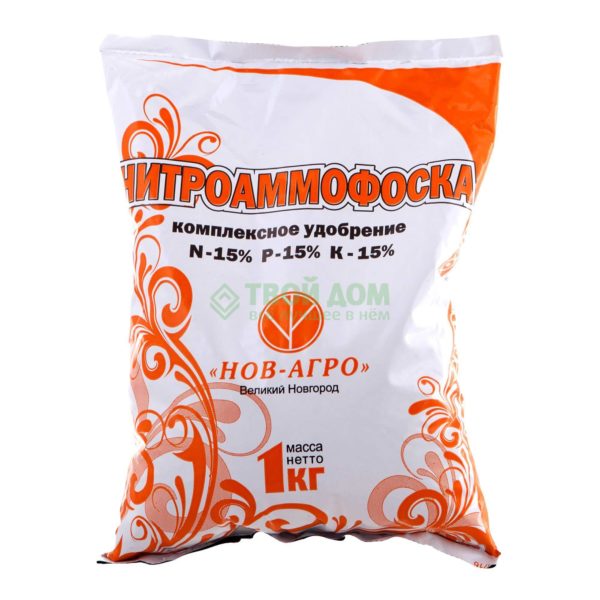
thank